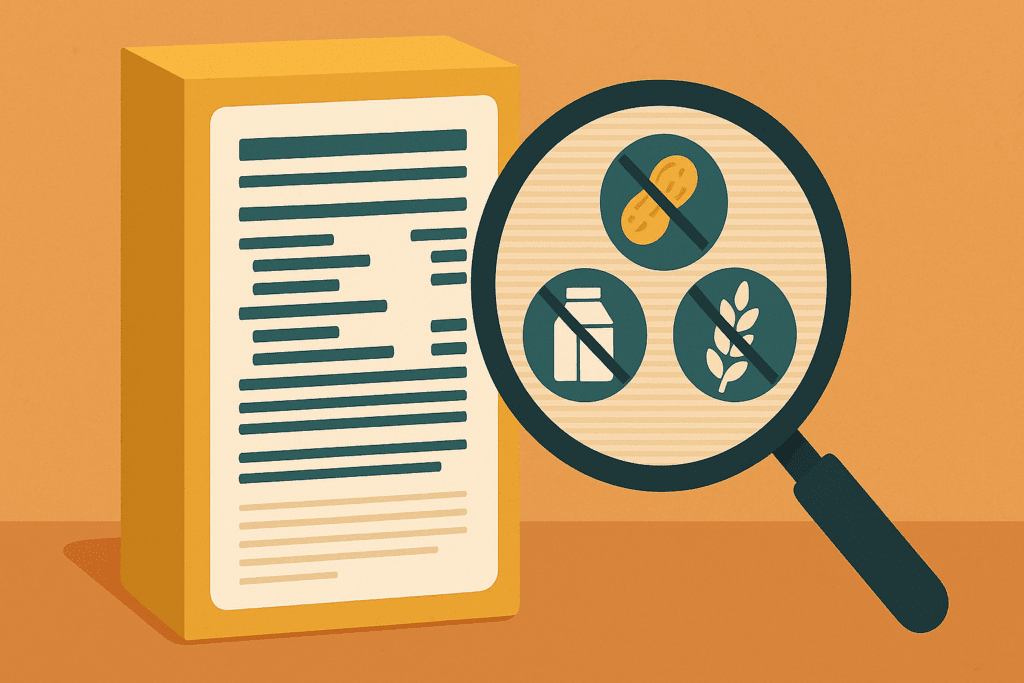Introduction: Why Food Labels Matter More Than You Think
When you pick up a package at the grocery store, you are making more than just a purchase; you are making a health decision. The “order of food label” ingredients and “what is listed underneath the ingredients on a food label” are crucial clues about the quality and composition of your food. While it might seem like a minor detail, understanding these labels can significantly impact your nutritional choices and overall well-being. According to the “food labels def,” a food label is a standardized tool designed to convey essential information about a food product’s nutritional content, ingredients, and potential allergens. The “food labels food definition” further clarifies that these labels serve as a communication bridge between the manufacturer and the consumer. In today’s world, where packaged foods dominate our diets, understanding the “order in which ingredients are listed on food labels” is not just useful—it is essential.
You may also like: 4 Ways to Have a Healthy Diet: Expert Tips Backed by Science for Better Nutrition and Long-Term Wellness
Defining Food Labels: A Critical Health Literacy Skill
Before delving deeper, it is important to solidify the “definition for food label simple term.” In its simplest form, a food label provides information about the ingredients, nutritional value, and other regulatory disclosures required by law. “Food labels define” the transparency consumers need to make informed decisions. Knowing the “food labels simple define” allows you to comprehend what you are consuming, ensuring that your health objectives are not undermined by hidden sugars, unhealthy fats, or artificial additives. The “food labels definition simple” focuses on clarity and consumer protection, ensuring that every package offers a snapshot of what lies within.

The Order in Which Ingredients Are Listed on Food Labels
One of the most critical aspects of a food label is the “order of ingredients.” Manufacturers list ingredients in descending order by weight. This means that the first ingredient listed is the most abundant in the product, and the last ingredient is present in the smallest amount. Understanding “the order in which ingredients are listed on food labels” provides insight into the true nature of the product. If sugar is the first or second ingredient, for example, you are likely dealing with a very sweet item—even if the marketing suggests otherwise. Recognizing “what is the name of how ingredients are in order” helps in decoding products to better align with your dietary goals.
What Is Listed Underneath the Ingredients on a Food Label?
Beyond the primary list of ingredients, many consumers overlook “what is listed underneath the ingredients on a food label.” This section often includes allergen declarations, manufacturing disclaimers, or additional nutritional notes. In many cases, allergens like soy, dairy, and nuts are “listed underneath the ingredients listed on a food label” to comply with regulatory requirements. Understanding “what is listed under ingredients of a packaged food” ensures that individuals with food sensitivities or allergies can avoid harmful exposures. It is not merely an afterthought; it is a vital extension of the ingredients list, safeguarding consumer health.

What Is the Purpose of a Food Label? A Simple Definition
“What is the purpose of a food label simple definition” centers on empowering consumers. Labels are designed to inform, protect, and guide food choices. They promote transparency and enable comparison between products. “Whats the purpose of food labels” is fundamentally to promote public health by allowing informed choices. The importance of this purpose cannot be overstated. In a marketplace flooded with thousands of options, “food labels examples” act as a compass, helping consumers navigate through the vast sea of available foods.
Decoding a Food Label from a Food Product
When examining “a food label from a food product,” it becomes clear that every element serves a specific function. Beyond ingredients and nutrition facts, labels often include serving size recommendations, calorie counts, and vitamin and mineral content. Some labels may also highlight marketing claims like “low fat” or “high fiber,” which are strictly regulated to prevent misleading consumers. By critically analyzing “a food label from a food product,” you not only see what the food contains but also what it may be lacking, such as sufficient fiber or essential vitamins. This practice is key to building a nutrient-dense diet.

How Ingredients Are Listed: Understanding the Order of Ingredients
“What is the order of ingredients” often reveals surprising truths about our favorite foods. For instance, in many cereals marketed as “healthy,” sugar can be listed among the top three ingredients, undermining the product’s health claims. Grasping “the order of food label” listings allows consumers to detect these inconsistencies. Similarly, “what is listed underneath the ingredients on a food label” may reveal hidden allergens or cross-contamination risks, adding another layer of essential information. Understanding “listed under the ingredient label” ensures that no critical detail is overlooked when assessing a food item’s suitability for your diet.
Listed Underneath the Ingredients Listed on a Food Label: Beyond Basics
Delving deeper into “listed underneath the ingredients listed on a food label,” consumers will find critical health information. This often includes disclaimers about shared manufacturing facilities or potential trace allergens. It may also include government-mandated disclosures about added vitamins, mineral fortifications, or preservatives. Knowing “what is listed under ingredients of a packaged food” can make all the difference for those managing chronic illnesses or dietary restrictions. It is one more reason why reading the full label—not just the front marketing—is crucial for informed dietary choices.
Food Labels Define Health Transparency
“Food labels define” the transparency framework within the food industry. By establishing what must be disclosed and how it must be presented, regulatory bodies ensure that consumers are not misled. The “definition for food label simple term” underscores that these labels are more than marketing tools; they are legally binding documents that protect public health. “Food labels definition simple” ensures that even individuals with minimal nutritional knowledge can still access vital information. The “ingredients label” is thus not a mere formality but a pivotal aspect of consumer rights.

Ingredients Label: A Closer Look at Your Food Choices
When scrutinizing an “ingredients label,” one quickly realizes the immense variety of additives, preservatives, and flavorings used in modern food production. Recognizing “the order of food label” ingredients and “what is listed underneath the ingredients on a food label” provides consumers with the tools to make healthier selections. For instance, a product whose “ingredients label” lists whole grains first and sugars later is generally more nutritious than one dominated by refined sugars and hydrogenated oils. By fully appreciating the “order in which ingredients are listed on food labels,” consumers can align their purchases with their health goals.
What Is the Name of How Ingredients Are in Order?
The technical term for “what is the name of how ingredients are in order” is “descending order by weight.” This principle is fundamental to understanding a “food label from a food product.” Knowing this, consumers can prioritize foods where wholesome ingredients like fruits, vegetables, or whole grains appear at the top of the list. Simultaneously, the presence of unwanted additives “listed under the ingredient label” becomes a clear warning sign. Recognizing “what is listed under ingredients of a packaged food” is equally important, especially when hidden sources of allergens, gluten, or processed sugars are involved.
Real-World Applications: Reading Between the Lines
Applying knowledge of the “order of food label” information in everyday life can transform your diet. For instance, when choosing a yogurt, understanding “what is listed underneath the ingredients on a food label” can alert you to the presence of hidden sweeteners or artificial flavors. Similarly, evaluating “a food label from a food product” when selecting granola bars can help you avoid products loaded with sugars disguised under names like maltose or corn syrup. Knowing “what is the order of ingredients” gives you the upper hand in choosing foods that genuinely align with health claims and your personal wellness goals.
Practical Advice for Healthier Choices
Armed with knowledge about “food labels def” and “food labels food definition,” consumers can make smarter choices that support long-term health. Look for products where natural, whole ingredients are listed first. Scrutinize “what is listed underneath the ingredients on a food label” for hidden allergens or additives. By internalizing “the order in which ingredients are listed on food labels,” you can navigate grocery aisles with confidence, making decisions that support heart health, weight management, and overall wellness. “Whats the purpose of food labels” if not to empower such informed decision-making?
Hidden Pitfalls and Marketing Traps
Food packaging can be deceptively persuasive. Buzzwords like “natural” or “whole grain” often adorn products laden with added sugars or excessive sodium. Understanding “the order of food label” ingredients helps cut through this noise. Additionally, being vigilant about “what is listed underneath the ingredients on a food label” reveals critical disclosures that marketing fronts might downplay. The ability to interpret “a food label from a food product” accurately shields you from falling prey to these tactics, ensuring that your food choices are driven by nutritional merit rather than marketing manipulation.
How to Teach Food Label Literacy to Others
Understanding the “order in which ingredients are listed on food labels” is a skill that should be shared. Teaching others about “food labels define” concepts can profoundly influence community health. By explaining “definition for food label” and emphasizing the importance of checking “what is listed under ingredients of a packaged food,” you empower others to make healthier choices. Real-world examples, such as comparing two similar products with different ingredient orders, illustrate these principles vividly and encourage better eating habits.

Frequently Asked Questions (FAQ): Understanding Food Labels and Ingredient Listings
What is the importance of understanding the order of food label ingredients beyond basic nutrition?
Beyond basic nutrition, understanding the “order of food label” ingredients can reveal hidden dietary patterns and food processing levels. Products with sugars, salts, or saturated fats high up in “the order in which ingredients are listed on food labels” can indicate highly processed foods that may negatively impact long-term health. Recognizing this order empowers consumers to choose whole, less-processed foods that align with anti-inflammatory and heart-healthy diets. Moreover, familiarity with “food labels def” helps in comparing similar products more intelligently, offering a practical tool for building balanced meals. It also equips individuals with the ability to detect greenwashing marketing tactics that attempt to overshadow unhealthy ingredients with buzzwords.
How can I use what is listed underneath the ingredients on a food label to identify safer food options?
“What is listed underneath the ingredients on a food label” often includes allergen disclosures, manufacturing information, and potential cross-contaminants. Learning to interpret this section can help consumers avoid foods processed in facilities that handle allergens like peanuts or gluten. Notably, spotting synthetic preservatives “listed underneath the ingredients listed on a food label” can help you avoid additives associated with hyperactivity or digestive issues. This layer of transparency goes beyond simply knowing “the order of food label” ingredients and into understanding food safety risks. Reading these disclosures carefully empowers smarter choices for individuals with sensitivities, allergies, or specific dietary needs.
How do food labels food definition and food labels def vary between countries?
While the “food labels food definition” and “food labels def” remain consistent in aiming for transparency, regulations vary globally. In the United States, the FDA enforces strict guidelines about “a food label from a food product,” including how calories, nutrients, and allergens must be declared. In contrast, European countries often require even more detailed ingredient sourcing, such as identifying specific oils used. These differences affect “the order in which ingredients are listed on food labels” and can influence buying decisions when purchasing imported goods. Awareness of these variations ensures that travelers and global consumers remain vigilant about “what is listed under ingredients of a packaged food.”
Why is it important to know what is the name of how ingredients are in order when managing health conditions?
Knowing “what is the name of how ingredients are in order” — descending order by weight — is vital when managing chronic conditions like diabetes, hypertension, or celiac disease. For example, a person monitoring sugar intake must scrutinize “the order of food label” to ensure sweeteners are not among the first few ingredients. Similarly, gluten-containing grains “listed under the ingredient label” can pose serious risks for those with gluten intolerance. Beyond just noting calories or fat, paying close attention to “what is listed underneath the ingredients listed on a food label” helps in identifying hidden culprits that could worsen health outcomes. This advanced food literacy is a critical self-management tool for long-term wellness.
What are some hidden risks found when examining what is listed under ingredients of a packaged food?
Examining “what is listed under ingredients of a packaged food” can expose several hidden risks, such as potential allergen contamination, presence of genetically modified ingredients, and use of synthetic additives. For example, even if a product appears healthy based on “food labels simple define” principles, the disclaimers “listed underneath the ingredients listed on a food label” could reveal cross-contamination with allergens. Additionally, some packaging might disclose the use of bioengineered substances, which is now a regulated requirement in some countries. Understanding these nuances means evaluating more than “the order of ingredients” — it means critically analyzing the complete manufacturing footprint. Consumers who diligently check these listings can avoid hidden threats that may not be obvious at first glance.
How do food labels examples demonstrate misleading marketing practices?
Many “food labels examples” highlight how marketing terms like “natural” or “whole grain” can be misleading if the “order of food label” ingredients tells a different story. For instance, a cereal box might boast about fiber content, yet if sugars appear first in “the order in which ingredients are listed on food labels,” the nutritional integrity is compromised. Similarly, examining “what is listed underneath the ingredients on a food label” can reveal hidden sweeteners or artificial preservatives that contradict the front-of-package claims. Learning to read “a food label from a food product” with skepticism is essential in cutting through marketing noise. This skill ensures consumers prioritize health facts over advertising slogans.
What emerging trends are influencing the evolution of the ingredients label?
The “ingredients label” is evolving with trends toward greater transparency, cleaner ingredients, and sustainability disclosures. Increasingly, brands are voluntarily revealing sourcing information “listed under the ingredient label,” such as whether ingredients are organic or Fair Trade certified. Regulatory pressures are also expanding “food labels definition simple” standards to mandate disclosures around bioengineered ingredients. Furthermore, some companies now highlight environmental impacts alongside “what is listed underneath the ingredients on a food label,” responding to growing consumer demand for ethical consumption. This shift enhances the role of “food labels define” not just for health but for broader lifestyle alignment.
How does understanding the definition for food label and ingredients order help with plant-based eating?
For individuals pursuing a plant-based diet, understanding the “definition for food label” and scrutinizing “the order in which ingredients are listed on food labels” is crucial. Products marketed as “vegan” or “plant-based” sometimes contain processed oils, added sugars, and chemical additives “listed under the ingredient label.” Being mindful of “what is listed underneath the ingredients on a food label” ensures that one’s plant-based diet remains wholesome and not merely vegan in name only. Checking “what is the order of ingredients” reveals if the product relies more heavily on whole foods or processed fillers. This strategic reading supports a truly health-conscious plant-based lifestyle.
Why should parents pay special attention to food labels for children’s products?
Parents need to be extra vigilant about “food labels examples” and “what is listed underneath the ingredients listed on a food label” when choosing products for children. Kids’ foods are often marketed aggressively, using cartoon characters and vibrant packaging to disguise poor nutritional profiles. Often, the “order of food label” ingredients in these products starts with sugars, refined flours, and artificial additives. Understanding “food labels food definition” empowers parents to see through flashy designs and prioritize whole, nutrient-rich options. Carefully examining “what is listed under ingredients of a packaged food” can protect children from excessive sugar intake, artificial dyes, and allergens.
How will future technologies enhance transparency in food labeling?
Future advancements will likely bring smart labels with QR codes that offer deeper insights into “a food label from a food product” beyond the traditional static print. These technologies could allow real-time access to sourcing details, environmental impacts, and even third-party health scores directly from “the order in which ingredients are listed on food labels.” Imagine scanning and immediately knowing not only “what is listed underneath the ingredients on a food label” but also the carbon footprint of each ingredient. As definitions like “food labels def” evolve with AI and blockchain verification, the “definition for food label simple term” will broaden to encompass trust, transparency, and traceability. Ultimately, understanding “food labels simple define” will involve engaging dynamically with digital tools as part of everyday food choices.

Conclusion: The Power of Knowing What’s Listed Underneath
Understanding the “order of food label” ingredients and “what is listed underneath the ingredients on a food label” is about reclaiming control over your nutrition and health. Armed with a clear understanding of the “food labels def,” “food labels food definition,” and “the order in which ingredients are listed on food labels,” consumers are better equipped to navigate an increasingly complex food environment. Recognizing “what is listed under ingredients of a packaged food” ensures that you are not only mindful of what you are eating but also of hidden ingredients that may affect your health adversely. Food literacy is more than a skill; it is a vital tool for achieving long-term wellness. By mastering how to interpret “a food label from a food product,” you take a powerful step toward a healthier, more informed lifestyle where each food choice supports your overarching well-being.


